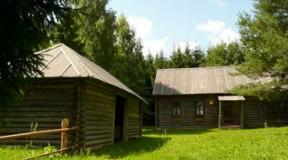2 herbs planting and care. Spicy herbs for the garden and cottage
Having your own plot and buying herbs on the market is, to put it mildly, unreasonable. You can grow everything in your garden and always have the freshest greens on your table, and be sure of their environmental purity. In our article you will find a list of herbs, recommendations for growing perennial and annual plants, photos with names and main characteristics.
Fragrant bed: preparation
Even from a small free space, if you use it rationally, you can get the maximum benefit. An ordinary garden bed or flowerbed - oval, triangular or round - is suitable for herbs.
A bed of spicy herbs looks beautiful, and everything planted on it is useful, but so that the greens do not lose their decorative value, they need care. Therefore, you need to arrange the garden bed in such a way that it is convenient to work.
In addition, there should be free access to the garden bed even in bad weather; therefore, paths paved with slabs or bricks are needed; in extreme cases, they can be covered with sawdust.

Herb bed
Tall plants are planted in the center, shorter ones - along the edge. They begin to prepare the site in the fall: they remove weeds and dig up. In the spring, the soil is once again cleared of weeds, loosened, then:
- mark paths;
- they limit the bed with a border, for which they use a cord to mark off the borders and install pegs;
- make a border from bricks or assemble a frame from boards;
- fill the bed with fertile soil and water it;
- pave the passages;
- seedlings are planted.
Attention! Most herb plants do not tolerate excess moisture. Therefore, if the bed is low, then a good drainage layer is needed.
Perennial herbs
The order of perennial herbs consists of:
- Fennel. Reaches 1.5 m, most often grown as an annual, because he is a southerner and cannot stand harsh winters. All its parts are used in the kitchen. The grains are used as a seasoning for fish, they decorate dishes with beautiful leaves, the heads of cabbage are stewed and served with meat.

- Lovage. Powerful, unpretentious spicy plant, reaching 2 m. It is planted both in the sun and in the shade - it feels good everywhere. Its leaves are a spicy seasoning for fish and meat dishes. The plant is a common component in traditional medicine.
- Hyssop. It is a half-meter, and sometimes taller, fragrant subshrub. Very picturesque when in bloom. Its flowers are most often purple or blue, but pink ones are also found. Spicy seasoning from its buds and leaves is used for salads, sauces, soups, meat and fish. It is a good flavoring agent for marinades and tinctures.

- Ruta. This is a subshrub 50-70 cm in height. Unpretentious, reproduces by everyone by known methods. As a seasoning it is good for lamb, meat fillings, vegetables, put in jars when canning tomatoes and cucumbers.
- Lemon balm is a bush 0.45-1.25 m tall, branched, grows well in the sun and in a slightly shaded place, the main thing is that the soil is fertile. It has a citrus flavor and is used in many dishes, giving them a bright flavor.

lemon balm
- Garden thyme. Low shrub 0.25-0.4 m. In addition to widespread use in medicinal purposes, also a good seasoning for soups, salads, sauces, fish, meat, vegetables.
- Sage is a powerful plant with panicle-shaped inflorescences, sometimes reaching 1.2 m. Useful both in the kitchen and in medicine.
Attention! Individual plants enhance the taste of herbs growing in their vicinity. These include canuper, cornflower, and wormwood.
Spicy annuals
A bed with herbs is not only perennials; without annual aromatic plants it will be incomplete. This list includes:
- Anise. Grows in light and fertile soil, loves light. Can grow over a meter. Fresh herbs are collected to season salads and side dishes. The seeds are added to sauces, baked goods, pickles, soups, kvass, and starters.

- Dill. Once you plant this plant once, it will then reproduce itself through self-seeding. It is difficult to name a dish where dill is not used, unless it is added to sweets.
- Basil. It grows in the form of a small compact bush, heat-loving, so it is better to grow it through seedlings. Fresh leaves are served on barbecue and used as a seasoning for many dishes. The branches are used for preservation.
- Parsley is an essential ingredient in many dishes. Both leaves and root are used. It grows in a bright place, prefers loose soils, and is not afraid of frost.
- Borage or borage. This plant with beautiful blue star-shaped flowers is a good additional ingredient for side dishes, meat, vinaigrette, fish, cold soups, and sauces. In addition, mature leaves are stewed like spinach and added to marinades and pickles. The flowers, both fresh and candied, are also edible. The bushes can grow in height from 10 to 60 cm.

Borage or borage
- Coriander. In appearance, the 80-centimeter bushes cannot be immediately distinguished from parsley, but the taste and aroma of cilantro are completely different. The plant is not capricious, grows in the garden without special attention to yourself. Greens are good in salads, as a seasoning for soups, and meat. The seeds are an indispensable spice for sausages, canned food, sauces, drinks, and marinades.
- Salad mustard. Surprisingly early ripening, cold-resistant plant. IN home kitchen They use its succulent leaves, which are collected before the flowers appear. They are put in salads, made into a side dish, and canned. Oil is obtained from the seeds and mustard is made. Powder made from seeds serves as a seasoning for fish and meat. It is included in spice flavor mixtures. This spice makes the stomach work more actively and increases appetite.

Salad mustard
- Marjoram flower. Unlike leaf marjoram, which grows exclusively in the south, flower marjoram is an annual and is cultivated in Europe. Spicy leaves and flower buds that have not yet blossomed are used. The latter are dried, fried, and added fresh to dishes. This spice can be found in the list of ingredients of the hop-suneli mixture. Housewives generously season fried and stewed poultry and pork with it, add it to cabbage, legumes, potatoes, minced cutlets, marinade, pates, drinks, mushroom and meat soups.
- Caraway. An ancient spicy plant up to 1 m tall, it would be more correct to call it a biennial. The seeds are mainly used as a flavoring for bread and other baked goods. Included in the list of spices for meat, gravy, vegetables, sauce, kvass. The root and leaves are added to salads. Essential oil, prepared from seeds, has a peculiar aroma.

- Kupir is another representative of the umbrella family that prefers shade. It tastes very similar to parsley, but has a slightly sweet smell, characteristic of anise. Just as fresh leaves are added as a spice, when dried, both the taste and beneficial properties are lost. Kupir is present in sauces, oils, and is added to cottage cheese when making sandwiches.
Advice. Marjoram will help you better tolerate a salt-free diet. It is also useful for diabetics as a salt substitute.
The spice bed is not only healthy, but also beautiful. Set aside a place for it in your garden and it will provide you with delicious additions to your dishes, and if necessary, it will also cure you of many ailments.
Herb bed: video
Spicy herbs: photos







Greetings, friends!
How beautiful a small vegetable garden with spicy crops looks on the windowsill! It is simply impossible to enjoy the aroma to the fullest during the cold winter season, when you so want the warmth of summer. The main thing is that, if desired, greens can be used for cooking or eating fresh, taking the necessary ones. How to grow herbs in your apartment? Spices growing on a windowsill at home, where to start? Of course, from seeds.
Where to buy seeds?
You can purchase seeds from a nursery or a specialty store. In it you will find a variety of herbs and vegetables. In addition, such stores sell ready seedlings herbs, which are sold in pots. If you have your own planting material, then you can use it too. When purchasing seeds, it is better to give preference to early varieties, this will make it possible to obtain green products earlier.
Seeds can also be ordered for home delivery, for example Here.
What soil should I use?
Most herbs prefer loose, nutritious soil. You can buy it already ready soil, which is sold in every flower shop. For planting, it is better not to use vegetable or garden soil, since it may contain pathogenic microorganisms, in addition, it is heavy and acidified. But if you still have to use garden soil, then it must be sterilized in the oven or held over steam.
Soil can be ordered with delivery Here.

There are also plants that do not need to be grown in the ground. For example, watercress, mustard greens or onions. To sow the first two options, you will need a damp cloth, which you need to spread in a container. You can use a paper towel or a layer of cotton wool instead of a napkin. The main thing for such cultivation will be constant moistening of the base.
Growing onions for feathers will become easy. The simplest method is to place the onion in water and expose it to light. In order not to form bad smell, needs to be changed more often water base, then the process of decay does not occur.
What container should I use?
It is possible to use absolutely any object that has a bottom and sides. In order to grow onions, you can use plastic jars with lids in which holes are made to accommodate a third of the onion. The jar is filled with water to the level of the onion roots. After this, all that remains is to add water. Gradually, the bulb decreases in size as it gives up its strength to green shoots. To continue feather forcing, you can add organic fertilizers to the water.
Of course, special pots, bright and colorful, are also sold for herbs. If you want, you can buy them too.

What herbs are best for growing on a windowsill?
People grow a lot of things at home, but there are some herbs that are preferred by almost everyone. They are used in cooking and planted on the windowsill, as herbs are easy to care for.
- Onion. Exactly how to grow it was described. We can only say that you should select the bulbs same size for landing. Must be removed first upper layer, in addition, some cut off the top for a quick appearance of feathers.
- Watercress. Easy to care for. It can be grown both in soil and in water; you can place the pot in the light or in the shade. It tolerates lack of light very well. Harvesting occurs when the sprouts reach a height of 5 cm. These greens are eaten in the form of salads and sauces. In addition, they are added to soups and sandwiches. This greenery contains various substances beneficial to the body.
- Leaf mustard. It is not inferior in ease of care to watercress. These species can be grown in one container. It is consumed both raw and processed.
- Dill. Widely distributed product. An unpretentious plant, but it’s better to purchase early varieties, from which you can harvest after 25 days. If you purchase a late version, you will have to wait for greenery for a month and a half.
- Leaf salad. Such a culture requires better conditions. She “likes” to be in bright light and warmth. Although the kitchen is ideal option for such a plant, but you will have to use artificial lighting.
- Basil. Loves warm places and will decorate any kitchen thanks to its green and purple leaves. If you plant several varieties in one container, you will get an interesting color composition. Optimal temperature for growing it is considered 25-28 degrees.
- Coriander. Unpretentious. Grows in almost any light. The only thing it cannot withstand is when the water stagnates or the soil dries out. Therefore, it is necessary to water the spice in a timely manner and in moderation.
- Lemon thyme. It smells delicious and fills the room with aroma. If you plant such a perennial, which also does not have any special requirements, then the subtle aroma of lemon will delight you for many years.
- Rosemary. This plant is a must for those who prefer Mediterranean cuisine. Possessing carved leaves and a wonderful spicy smell, this herb will please the eye and give pleasure to the aromas. Can be purchased small plant or grow from seeds, although this will take a lot of time and will require a lot of effort.
- Parsley. This herb can be grown by seeds or by forcing it from the roots. The second method will allow you to get the harvest faster. To grow, you will need a warm, bright room and even watering. Parsley does not really like to live on the windowsill, but is in demand among gardeners.

It is especially useful to grow herbs in winter time, when there are not many vitamins, and fresh greens in stores are quite expensive. But even in summer, a small garden with herbs on the windowsill can diversify the interior of the kitchen and make dishes aromatic and tasty. Growing herbs on a windowsill is an easy and interesting activity. If you choose the right plants, you will get not only an evergreen bed, but also a spectacular flower mix. Today you can purchase ready-made containers for growing greens. Typically, such boxes are equipped with separate “pockets” where you can grow greens with a small root system.
Many gardeners transfer developed plants directly from the garden bed to the house. This is a great way to get a green garden with fragrant herbs without unnecessary hassle. Many perennials feel good at home, including:
- motherboard,
- sage,
- thyme,
- Melissa,
- Caber.
Before transplanting, the plants are watered well, dug up, and the roots are shortened if necessary. After planting in a box, the shoots should be trimmed. This will facilitate adaptation and improve the growth of new greenery.
Typically, plants used for growing greens are unpretentious. They easily settle into a new place and quickly grow. Growing herbs on the windowsill allows you to get fresh herbs at any time of the year. True, in winter, herbs need additional lighting, otherwise the leaves will be pale and weak.
Soil selection
A home garden bed should be loose, breathable and, if possible, nutritious. However, you should not overuse fertilizers, because the resulting greens will be used for food. So there shouldn’t be any other applications besides organics. Garden soil is usually heavy and acidic, so it is advisable to use a ready-made substrate. Universal soil will do just fine. It contains the required amount nutrients, it is light, loose and well permeable to moisture.
To grow herbs on a windowsill, you will need a fairly high container where you can provide good drainage. If we are talking about growing 1-2 plants, but regular one will do flower pot.
Some plants don't need soil at all. Watercress and leaf mustard feel good in the water. It is enough to create the necessary humidity by placing moistened cotton wool or special moisture-retaining granules at the bottom of the container. It is important not to let the roots dry out, otherwise the plant will quickly die. In a similar way You can grow onions for feathers. Usually glass containers or plastic jars. When creating a home garden, you can disguise water containers with moss or sprinkle decorative stones. Then you will be able to make an effective and beautiful garden bed, which will give the interior a special charm.
What to plant
It is quite possible to grow at home various varieties lettuce, sorrel, parsley, dill, marjoram, green onions and cilantro. Compact varieties of cherry tomatoes, hot peppers, early ripening and low-growing varieties cucumbers By the way, chives also feel great in the home garden and go well with greens.
Among the unpretentious plants are:

More demanding plants include lettuce, lemon balm, sage, and rosemary. Much is determined varietal characteristics plants. Before purchasing seeds, you should check with the seller how well the plants will do at home. For example, some sage varieties have big sizes, and rosemary can be difficult to grow on a windowsill. Leaf lettuce usually requires additional lighting: it does not go well with greens when indoor lighting. It is worth noting that most herbs go well with each other and are suitable for growing together. Almost all herbs love bright light, high humidity and a temperature of about 25 ° C.
Secrets of successful cultivation
All herbs, except onions and watercress, need long daylight hours. Therefore, they provide additional lighting from the garden beds. IN summer time It is advisable to place the box with the plant on the balcony; in winter, even if there is a south window, the plants will have to have additional lighting. Lamps are often installed in the kitchen daylight that provide good lighting in work area. Such a lamp will be quite enough to improve the growth of green pets. With a lack of light, the plants quickly stretch out and have small, pale greens. IN good lighting Basil, almost all types of lettuce, mint, rosemary, etc. are needed.
To be guaranteed to become the owner of a luxurious green bed at home, when choosing seeds, you should buy only early ripening varieties. It is also necessary to check the timing of seed release, since many herbs quickly lose their viability.
It is quite difficult to grow parsley at home. However, this plant is very popular, so many herb lovers are making attempts to grow herbs at home. For these purposes, a spacious box, nutritious soil and good drainage are suitable. Parsley grows best outdoors: on a balcony or veranda.
Those who want to grow both a decorative and useful garden bed should pay attention to perennials: marjoram, mint, sage. These plants can please the eye for a long time appearance, while pinning the leaves will have a positive effect on the aesthetics of the decorative bed. However, if the green pets remain in one place for a long time without replanting, they will quickly grow and deplete the soil, so that the home bed will have to be renewed annually.
Spicy herbs respond well to spraying and do not like high dry air. Dill, mint and basil will not give good harvest with a lack of moisture. To increase air humidity you can make a mini-pond, diversify the composition and create an optimal microclimate. 
Many lovers of plants on the windowsill approach arranging a home garden bed with imagination. For planting compact plants, which include almost all herbs, old cups, sugar bowls, oil dishes are suitable, which will give the kitchen interior original look. Convenient to grow greens in plastic bottles. If you turn the bottle horizontally and make round holes in the top of the bottle and pour water inside, you can get an ideal container for forcing onions. And if you place the bottle vertically and cover it with soil, you can get a compact vertical bed for growing low-growing greens, such as dill and parsley.
You cannot make a bed without a drainage layer. It is almost impossible to shed the soil properly without damaging the root system of plants. To improve water exchange, you can use hydrogel, which is added to the soil during planting. It retains moisture and, on the one hand, protects plants from overwatering, and on the other hand, releases excess water when the roots lack moisture.
Basil
It can be used dry as a seasoning for meat dishes; it reveals itself especially well if used with tomatoes. Added fresh to any fresh vegetable salads.
In Siberia it is grown as an annual, either through seedlings, or by direct sowing in the ground in early or mid-May. But first you need to protect the crops with at least agrotex.
Can also be cultivated in a greenhouse. The combination of basil with pepper and eggplant is especially useful; this herb repels aphids with its smell.
Purple and green basil with peppers. Photo Nadya
You can grow basil at home - on a window or on a balcony. But remember that basil is heat-loving and does not tolerate frost.
We sow basil for seedlings at the end of April. I sowed it in a small bowl in bulk. The amount shown in the photo was enough for me both for salads and for drying.


Once this size is reached, it can be planted in the country, provided that there are no more frosts. Photo Snowy summer: “I used to sow directly into the garden bed. But germination is also worse, and it will be possible to use it later.”
If there is not enough space on the windowsill, then you can simply buy a pot of basil in the store, eat the leaves, then trim the stem, leaving about 5-10 cm, and replant it in the garden bed.
Mushroom Herb (Fenugreek or Fenugreek)
Makovka: “Fenugreek, or Mushroom Herb, smells very tasty when ripe. It is added to meat dishes, and all Georgian spices contain it, such as adjika and satsebeli.” Can be added to potato and mushroom dishes, vegetable soups, and manti filling.
We sow this annual along with basil, but closer to mid-May. Makovka: “We grow in two types: legume (Fenugreek) and herbaceous (Trigonella). We sow the seeds that we collected in the spring, everything comes up beautifully.”

Photo e_z: “I collected seed pods from fenugreek for testing. Overall, this thing smells amazing, but I tried the seeds and they taste bitter. On the fenugreek itself there are even lighter and darker boxes.”
Mushroom grass should be mowed when a little more than half of the beans turn yellow, at a height of about 10 cm above the soil, spread out in a draft and dried, protected from rain. Then collect the seeds and dry a little again. And the tops of fenugreek themselves should be dried in the shade. Then chop and store in a sealable container.
Hyssop
Perennial small cold-resistant bush. It grows in one place for 5-7 years. Propagated by sowing in May through seedlings, or by dividing the bush. MNBer adds: “Hyssop overwinters excellently, moreover, it germinates by self-sowing.”
Hyssop must be planted separately from other crops, otherwise it will simply crush them.

Hyssop. Photo S-Anka
Coriander (Cilantro)
An annual from the Umbellaceae family, very popular in Caucasian cuisine. They sow in May and August, and take a break in June-July. Prone to intensive self-seeding.
Young leaves are consumed.
It is also useful because, when dried, it can repel mice and woodlice in private homes.
Lavender
This perennial can be grown either with stratification for a couple of months or without it, with sowing in March. However, when grown through seedlings, lavender will bloom only next year. It is quite capricious, often it either freezes all over or rots away, but you can make a dry shelter for it for the winter (with spruce branches, branches).
Used to rub turkey and lamb before roasting.
Photo Nath
Lovage
Perennial of the Apiaceae family. Mirage: “It grows as a large bush, the stems dry out in the fall. I collect and dry the leaves. Such a aroma when you add it to the soup! Just don’t overdo it - it will be impossible to eat. I once threw a branch of fresh lovage into a pot of borscht. After 10 minutes I took it out, but it was impossible to eat the borscht.”
Also used in pickles to add a mushroom flavor, for fried meat and sauces.
Propagated by sowing before winter or in spring in the ground, followed by thinning so that the bushes do not grow crowded. But it is better to use vegetative propagation.

Photo Doriana
Marjoram
Perennial from the genus Oregano. Drought-resistant, light-loving, thermophilic. Good for fish dishes, salads and as a flavoring for vinegar. Included in many herbal teas. Collected at the beginning of flowering.
Sowing in April to a depth of 2-3 mm, cover with glass. It usually germinates well. But it cannot stand the cold at all; it needs to be grown at home in a warm place, and even more so in the country. Can be propagated by cuttings and layering.
Melissa
Perennial, used for soothing preparations, for mushroom dishes, fish, salads and tomatoes.
It is very easy to grow from seedlings; sowing can be done throughout April. It tolerates transplantation to a permanent location very well. You can also sow directly into the ground in mid-May. During the summer it is cut back many times. Can't stand overwatering and starts to turn black.

Melissa seedlings on May 9, sowing on April 1, you can already pick leaves for tea. Photo Nadya

On permanent place spreads in all directions, so it is better to plant separately. Photo Nadya
Mint
Used in the same way as lemon balm. The leaves are cut off at the beginning of flowering, several times during the season.
It is better to grow this perennial from seeds or ask someone to dig up part of the bush. When sown or in loose soil, however, mint takes a long time to germinate, up to 2 weeks. Picking and lighting are needed. Do not water mint too much.

Photo Galchonok 23
Mint repels the sea buckthorn fly, so it’s a good idea to place it next to the sea buckthorn.
Borage (Borage)
The young leaves of this annual plant smell like cucumber. An excellent seasoning for meat, and can also be added to salads instead of cucumbers and in vinaigrette. They say this grass was fed to gladiators before battle.

Eugene 17:“Another interesting herb is Borago (borage grass). The leaves are pubescent, soft, with a strong cucumber scent. Only she's early. You can plant radishes in parallel and get the harvest almost simultaneously.” MNBer adds: “Borago seeds are sold in every seed store. It is enough to plant this grass once, and it will reproduce by self-sowing.”
Oregano (Oregano)
A perennial, it can be grown by seeds or through seedlings, or by direct sowing in the ground, or by layering from a bush, you can even bring forest oregano and “domesticate” it, it will be much more fragrant than the “cultivated” one.
Used not only for tea, but also for homemade sausages and pates, as well as fried meat and gravy.

Photo Mammy_Nati:“True, I sprinkled the oregano seeds without looking, and they sprouted not after 10 days, as the inscription on the package promised, but after 2 months, I actively fed the soil with fertilizers, perhaps this helped, the seeds became stronger and sprouted well.”

Drying St. John's wort and oregano for tea. Photo Varvara Plyushkina: “I dry everything in bunches. I have summer cuisine, that’s where I hang it on ropes. It hangs for about 1-1.5 weeks, then I take it off, the grass is completely dry, I cut the stems (up to 20 cm) and flowers (I have armor-piercing Tupperware ones that cut everything) with scissors, and put them in linen bags. I sewed cotton bags with strings. I store them in them. Each type of grass has its own bag, there are smaller ones and larger ones.”
Rosemary
Varvara Plyushkina:“Of all the aromatic seasonings, it is the most delicate. Although rosemary is sold in dried form, it is indistinguishable from Christmas tree needles, they are just as hard and prickly, but the taste is wonderful. It is used in any dishes with chicken, any meat, barbecue, etc.” MNBer adds: “Rosemary can be used in hot dishes, in salads, in desserts, and it is medicinal and used in cosmetology. Basically, put it next to the porch and add it to everything.”
This perennial is very difficult to reproduce by seeds, it takes a long time to germinate - it can “think” from February to April even after stratification. But the siblings came up with a clever way to grow rosemary without any hassle with seedlings! At the end of April - beginning of May or even later, you can buy rosemary sprigs in the store and put them on rooting. Onli You notes: “The apical ones stuck into a peat tablet take root best.”


Then you need to place the plant in a greenhouse bag. Photo Snowy summer

In a week or a week and a half it will be possible to transplant it into a pot for home use. Photo Martusha
And, of course, you can also plant this herb in your dacha. MNBer advises: “He loves both bedding and dusting with chalk or dolomites, and the soil is slightly alkaline.” In the fall, if desired, a large, overgrown bush can easily be moved back into a pot and taken home. You can grow rosemary at home in large pots, as he writes MNBer: “I read and reviewed everything I could about rosemary. It is a perennial and grows quite large in its homeland. big bush, and it can be planted both in the ground and in very large containers up to 10 liters.”

Photo Martusha:“Here is my bush from one rooted branch, cut several times.”
The difficulty in growing rosemary is that it can easily be frozen even at home, as he writes Dashechnaya: “In my pot on the window (window to the northwest) in 2.5 years the shoot grew from 15 cm to about 80-90 cm! But he was successfully frozen by his husband. I didn’t particularly prepare the land - dacha land mixed with terra-vita. Well, as I wash it out, I add Terra Vita. Now it’s about 50 cm. This year it froze again, more on the bottom, I revived it with Epin... Now such rich greenery has grown on top...”
Rosemary can also begin to turn black at the bottom and does not live long, about two years at most. Therefore, you will have to buy rosemary sprigs for cuttings every one or two years.
yul81-05 shares: “100% rosemary does not winter here in Siberia, they told me about this at the Botanical Garden, that’s why they sell it there, as indoor plant. After the purchase, I replanted it and put it on the window, but it looks like it needs some lighting because it has become very stretched out.”
The pest of rosemary is the whitefly.
Rain grew rosemary from seeds: “Last year I sowed rosemary with seeds - surprisingly, they all sprouted... Before planting, I didn’t do anything with them, I just put them into tablets and put them in a greenhouse... I planted a couple of bushes in the garden - where did they even go? I don’t know... And three bushes at home are sitting in one pot... It’s a little rare, of course, despite the fact that I broke it off, somehow it doesn’t bush very much.”
Photo Rain
Fennel
Many plants, except cabbage and cucumbers, are incompatible with this relative of dill, so it is planted in the farthest corner of the garden. Yes, and it is growing quite well. Therefore, they sow it in rows of 50 cm, the sowing depth is about 1 cm. Hilling is necessary to thicken the stem. Fennel is harvested when the bottom of the stem reaches 8-10 cm in diameter. It can be pickled (200 g of salt per 1 kg of leaves), frozen or dried, like dill, and used for salads, fish and meat dishes, sauces, .
Eugene 17 writes: “Last year I planted fennel “Udalets”. I just sowed it in the garden like dill. He rose like a carpet. I pulled through. The leaves are shaped like dill. Very tender, sweetish, a little spicy, but without a strong smell. By the end of summer, waist-deep bushes had grown out of the bushes. Heads of cabbage began to form at the base. Where it was sparsely planted, excellent ones formed; where it’s thick, it’s thin. Tall stems protrude from the heads with dense foliage that remained tender all season. The heads of cabbage are eaten. As I understand it, they are the main harvest of the plant. But it never dawned on me what to do with them and how to cook them, so we only used the tops: we ate them in all the salads, and dried them like dill.”
Citronella (Lemongrass or Lemongrass)
The perennial is used in the famous Thai Tom Yum soup. It is also used in drinks. Lun@riya writes: “I brewed pure green tea, without any additives, with finely chopped fresh citronella (I accidentally saw a tea set in the store recently - mint + thyme + lemongrass). To my nose, the aroma is simply amazing! Thin, light, and the tea has a slight sourness. Well, it probably depends on the quantity.”
You can propagate by seeds, as he writes Svetyla: “I sowed Citronella last year; the store clerk highly recommended its seeds to me - both as a mosquito repellent in the country and as a very healthy herb. In the summer this herb grew in a pot at the dacha, in the fall we brought it home, and it grows beautifully in room conditions. The stem is very tough, but the lemon flavor is just superb. I really like tea with it.”
But it’s easier to buy a set of fresh herbs for tea in almost any large supermarket, preferably with a “heel”, cut off the bottom by 3-5 cm and root it in a peat tablet.

Photo Onli You
Then plant it in a greenhouse, because this plant is extremely heat-loving. Take it home for the winter in the fall. TUMAN writes: “The plant simply grows on the window in winter. I water it abundantly. I propagate by layering. In the spring I plant it in a greenhouse, and there is also plenty of watering. Before the New Year, many non-economy class stores offered Thai fruits, vegetables and herbs. There were tom yam kits on sale.”
Lun@riya adds: “And for those who come across grass with an onion.” To make it easier for it to give roots, I removed 1-2 top scales, this will open a small stem, and the roots will come out of it faster. I bought 2 of these sets, I specifically chose them based on their appearance lemon grass to be with the bottom. I ended up with 4 potential cuttings. She took off the top scales and put them in water. Now they have already given roots, decent ones. They’ve even already managed to get intertwined.”
Forum members from the south of Russia grow lemongrass, for example, Nekonomicon advises: “Girls, about the lemongrass seeds - they need a lot of sun, then they will. I now live in Sochi, I sowed a pinch of seeds, only one sprouted. But it is growing confidently, already a clump of several stems and several spikelets with seeds. They are falling everywhere, I feel like they will overgrow all the neighboring pots. It also quickly depletes the soil; in the summer, fertilize more abundantly.” elichka007 from Krasnodar region says: “I met him in Tai, like many, and I desperately wanted to have a home. I grow it in 2 ways - through seeds and through stub cuttings, which I bought at METRO. I'll tell you about the stumps from the store. The idea of putting them in water did not come immediately, I did not think that anything would come of them, since the trunk was severely cut off, and there were not a single root. I put 3 pieces. into a glass of water, mixing in a root formation stimulator - Kornevin. And, lo and behold, a week later tubercles appeared from the trunk, then roots. When the roots grew, I planted them in a pot. I watered it often, it sprouted leaves, and in May I transplanted them into the ground. Now this bush has given birth to a bunch of babies. From one trunk there are about 20 fat babies for sure. And the second way is through seeds. I bought the seeds in a regular online store, seeds from the Plasma Seeds company. Everything that was in the pack sprouted. Planted in December. At first I kept it under the film, then opened it when they got stronger. I planted them in the ground in April (they turned purple and then moved away) and now I have 3 huge bushes. But the trunks are not as thick and fleshy as those from grown stumps. Apparently, it needs two years to grow thicker, or I planted it densely. The aroma is unreal. They look great on the site. I plan to bring some of it indoors for the winter, and the rest for drying.”

Photo elichka007
Savory (Pepper herb)
Savory is sown directly into the ground in the first ten days of May, to a depth of about 1 cm, followed by thinning by 10-15 cm. The leaves are cut off during the flowering period, then dried. Used in soups, main courses and pickling.
Savory winters well and can be planted in the spring.
Thyme (Thyme or Bogorodskaya herb)
The perennial is good not only for tea, but also in meat and fish dishes, pates, smoked meats and for pickling cucumbers.
You can sow from March to April. With early sowing, thyme can be harvested in April, and at the end of May it can be planted in the ground. It grows instantly in the ground. It is cut repeatedly and then needs to be dried.
And other herbs landscape designer and TV presenter Olga Voronova will tell you how to make a special bed for them - not a garden bed, but more like a flower bed. How to plant dill and coriander, mint and lemon balm, oregano and thyme? How to beautifully design a bed for herbs?
Spicy herbs significantly enrich the taste of any dish; they can be frozen and dried, and vitamin teas can be brewed from them. Among other things, they repel many pests.
Many herbs - perennials. Once you plant them, you can forget about them - they will grow on their own, regularly providing you with greens rich in vitamins.
Spicy herbs start in early spring, one of the first, when there is still almost no greenery on the site. They can be designed as a separate landscape object - a spice bed. It will become one of the elements of a beautiful garden, original and practical. This will be a flower bed, a decoration bed. Its place is not in the garden, but in any of the recreation areas, in the front garden or in the front area of your garden.
You can lay it out of stone in the form of a spiral, make a raised flower bed of any shape, or you can simply cover a small piece of earth with beautiful stones. At the same time, such a beautiful object needs some kind of additional framing; gravel dumps are best suited for this purpose.
You can also decorate a spice bed with stones, but smaller ones, shards of ceramic products, small vessels, figurines that just need to be placed between the spice bushes.
How to make a herb bed? Master Class
- Select appropriate place for a future spice bed. Mark the shape using pegs and string.
- Dig up the area and remove the weed roots.
- Place boulders and (or) large rubble stones along the contour of the future bed. You can also use granite.

- Dig up the soil within the borders of the bed again.
- Place the pots of herbs in their places.

- Along the outer perimeter of the bed, use a shovel to dig a narrow trench 10 cm deep and approximately 8-10 cm wide.

- Place geotextiles in the trench so that it covers not only the bottom, but also the sides. Temporarily secure it with individual stones.

- Fill the trench with crushed stone or gravel to ground level. This backfill will beautifully frame the bed and prevent weeds from getting into it.

- Plant seedlings and herb rhizomes in the garden bed with large spaces between plants as they will become very large. In between, you can sow annual spices here and there, such as dill and coriander.

- Decorate the bed with rocks, garden figures or decorative solar lights.
Spicy herbs: which ones to plant
Dill and fennel. It makes no sense to grow these plants, indispensable for every gardener, through seedlings. Sow directly into the ground. For early use - in the greenhouse soil. Be sure to sow thickly if you want to get especially juicy and tender greens. If you grow some part for “umbrellas”, on the contrary, sow less often.
Dill and fennel reproduce well by self-sowing, so more and more new plants will appear in your garden. various places garden this year and next. Sow dill every 2 weeks, and until late autumn you will be provided with fresh herbs for the table. Main secret success for dill - abundant watering.
Lovage. The king of herbs, very rich in vitamins. This is a large plant that produces a large mass of greenery. The taste of lovage unites the tastes of almost all herbs, and it can be used to prepare any dishes.
Planting lovage seedling method, sowing is carried out in early March. His germination is always good. Sow thickly and plant in open ground in early May. If you want to have young lovage leaves throughout the season, prune the plant regularly. Its further propagation is carried out by dividing the bush.
Caraway. It is indispensable for canning, preparing sauerkraut, preparing meat dishes and bread. Grown by seedlings. Sow cumin thickly in pots at the end of February, and also plant it in the ground. Best time for disembarkation - early May.
Tarragon. Basically, it's a nasty weed. It is easier to start it on the site than to take it out. Therefore, it is better to plant it not in the garden, but in the far corner of the garden. It will give a rich harvest regardless of growing conditions.
In cooking, tarragon can be used almost everywhere, and it can turn homemade preparations into real delicacies. The growing method is similar to the method of growing other herbs, seedlings. The timing of sowing and planting in the ground is the same.

Mint. You will not have any problems growing mint. The only thing that needs to be done is to limit the area of distribution of this plant: you can dig a large container into the ground or fence the area with slate.
Mint can be propagated by seedlings by sowing the seeds as widely as possible. early dates, or you can also divide the bush if you or your neighbors already have this plant. However, seedlings need to be planted in the ground later, in July-August.
Melissa. Has a wonderful lemon aroma. It is less aggressive than regular mint and more sensitive. If lemon balm is not insulated for the winter, it may freeze in severe winters.
Basil. In cooking, basil is used both on its own and together with lovage. This plant is also very aesthetic - it can be planted in containers and pots for decorative design plot.
Basil is the most heat-demanding spicy annual; it cannot even tolerate temperatures of 0°C. Therefore, there is only one way out - to grow basil seedlings and plant them in the ground no earlier than May 15, or to sow them in a greenhouse. In mid-May, you can sow another portion of basil in open ground.
Basil is very demanding when it comes to watering. It needs to be planted somewhat thickly. He is also responsive to feeding.

Oregano (oregano). This medicinal plant very decorative and exudes a wonderful aroma. But oregano is good not only for tea - it is widely used in cooking. The method of propagation is the same as that of mint. The secret to success: you need to add a little sand to the soil.
Coriander (cilantro). It is grown for its fresh aromatic greens and seeds, which are widely used in cooking. This “garden spice” is an annual plant; it is sown in open ground in early May.
The seeds are collected as they ripen. Coriander is capable of producing 2-3 harvests per season. For it, only abundant watering is important, otherwise it will grow under any conditions.
Thyme (thyme). As a spice, it is used in various dishes, as well as for making tea and in home cosmetics. It blooms in June-July, the bushes need to be trimmed periodically. Thyme does not tolerate frost well and needs shelter.
Clary sage. Very unpretentious plant, which is easy to grow from seeds. Blooms for a long time. Used as a spice for confectionery.
Rosemary. Not only a spicy plant, but also a medicinal plant. Used for preparing dishes from lamb, potatoes, root vegetables, and for flavoring olive oil. Frost resistance of rosemary is average, so shelter in winter definitely won’t hurt. You can use rosemary using herbs sold in supermarkets.
Hyssop. A spicy herb that is especially good for cooking meat dishes and marinades, and it also blooms beautifully. Hyssop is unpretentious, very frost-resistant, and is easy to grow as seedlings from seeds.

Monarda. Monarda is also called “bergamot”, as its smell is almost identical to bergamot. But real bergamot is a completely different plant. Thanks to its aroma, monarda is indispensable for tea. It has calming and analgesic properties. You can add it to meat dishes.
In addition, it is a bright, showy perennial. The plant itself is quite tall, and its flowers resemble multi-tiered “shaggy” crimson plumes with green spaces. It is often grown just like a flower, for decorative purposes.
Comment on the article "Basil, cumin and 12 more herbs: growing in open ground"
Section: -- gatherings (Spicy herbs). What are your favorite spices and herbs? I used to love mixtures of herbs from the Provençal or Italian series, but now I like them separately. I like to add allspice to simple dishes. And we use a lot of spices.
Basil, caraway and 12 more herbs: growing in open ground. at the end of June, July - black radish, turnips. zucchini or zucchini (it’s not too late), basil (cilantro), early cabbage, potatoes (not all peppers, tomatoes are easier to buy as seedlings in June, and only if you...
On the beds. Cottage, garden and vegetable garden. Cottage and dacha plots: purchasing, landscaping, planting trees and shrubs, seedlings, beds, vegetables. Greenery will not grow soon. What will grow well on a windowsill? We are talking specifically about greens: salads, purslane, spinach, watercress...
On the beds. Cottage, garden and vegetable garden. Dacha and dacha plots: purchasing, landscaping, planting trees and shrubs, seedlings, beds, vegetables Of course, I don’t plan global gardening, but I want 1 bed with strawberries, 1 bed with herbs + aromatic herbs and mint, and...
On the beds. Cottage, garden and vegetable garden. Dacha and dacha plots: purchasing, landscaping, planting trees and shrubs, seedlings, beds, vegetables. Please tell me where arugula seeds are sold. What greens do you recommend growing in the village (Yaroslavl region)?
Basil, caraway and 12 more herbs: growing in open ground. it can be accurately identified when it blooms - its flowers are lilac-violet, while oregano's. Can a pregnant woman... use spices? Basil, rosemary, thyme: growing from cuttings.
Basil, caraway and 12 more herbs: growing in open ground. In mid-May, you can sow another portion of basil in open ground. Basil is very demanding when it comes to watering. I freeze it, like dill and parsley. If possible, I use it in winter too...
Basil, caraway and 12 more herbs: growing in open ground. Basil, rosemary, thyme: growing from cuttings. Moreover, you don’t need to buy seeds, sow them and wait a long time until the tiny shoots of Basil have already sprouted, by the way.
Basil: beneficial properties of an aromatic spice. However, basil has rare beneficial properties in the treatment of many ailments. Basil, caraway and 12 more herbs: growing in open ground. Spicy herbs: do-it-yourself garden bed, master class...
Basil, caraway and 12 more herbs: growing in open ground. Its place is not in the garden, but in any of the recreation areas, in the front garden... how to make a special bed for them - not a garden bed, but more like a flower bed. Its place is not in the garden, but in any of the recreation areas, in...
To always have fresh herbs on hand, you will need pots. Both of these perennial crops are small shrubs, so quite Thyme is also planted in open ground, and not necessarily in a garden bed. As a result...
Help Wanted - home garden bed. On the beds. Cottage, garden and vegetable garden. how often to water? We bought a long narrow tray, “living soil”. I would like there to be a riot of aromatic greenery, not so much for food, but for aesthetics, for smells...
Basil, caraway and 12 more herbs: growing in open ground. Spicy herbs: do-it-yourself flower bed, master class with photos. How to beautifully design a bed for herbs? Spicy herbs significantly enrich the taste of any dish; they can be frozen and...
Basil, caraway and 12 more herbs: growing in open ground. Many herbs are perennials. Once you plant them, you can forget about them - they will grow on their own, regularly providing you with greens rich in vitamins.
I can't find the right spices at all. Special mixtures of spices (as they sell in markets) are not suitable - no one likes them: (Please help. I always put the mixture in the minced meat: I grind black, allspice, white pepper myself, add a tiny bit of red hot...
"Other names: spicy cumin, Egyptian cumin, Voloshsky cumin, an annual herbaceous plant of the Umbelliferae family. Basil, cumin and 12 more herbs: grown in open ground. It will give a rich harvest regardless of growing conditions.
How to beautifully design a bed for herbs? Spicy herbs significantly enrich the taste of any dish; they can be frozen and In the old days, it was believed that if there is no fruit trees, shrubs, flowers, fragrant herbs, as well as vegetable crops, then the area is not...
Basil, caraway and 12 more herbs: growing in open ground. Once planted, you can forget about them - they will grow on their own, regularly providing you with rosemary. You can grow rosemary from cuttings using herbs sold in supermarkets.
When I bought it, they said that in open ground conditions it is an annual, but in indoor conditions it seems to be because it does not survive the winter in open ground. 05/21/2001 03:13:27, Marinka. Basil, caraway and 12 more herbs: growing in open ground.



















